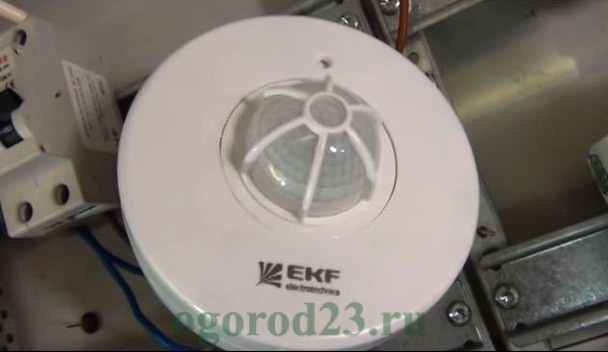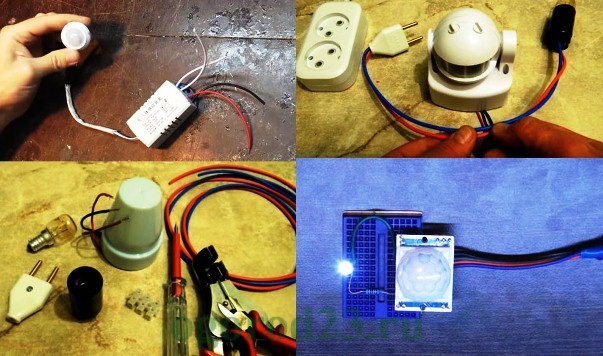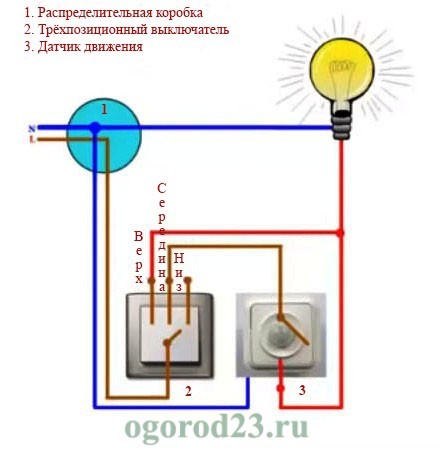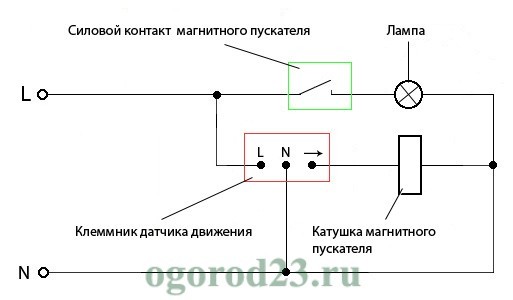Modern technologies bring convenience to our lives, increase the comfort of our existence. Motion sensors for turning on the light help to rationally use resources (50-80% energy saving), detect the presence or movement of objects. Where can motion sensors be used?
Yes, anywhere. More specifically, where a person stays for a short time, that is, in the corridors, on the stairs, storerooms, at the entrance to the house, the gates of a private house. Also, this device is extremely convenient when you need to turn on the light, but at the moment your hands are busy with something. When the object moves, the light turns on automatically, and if there is no movement for some time (which is set individually), it goes out.

The motion sensor is a special device that belongs to the category of detection devices. With the help of sensors, it captures a moving object that falls into its coverage area, transmits the received signal to the lamp.
When purchasing a motion sensor to turn on the light, it is necessary to take into account its parameters, features:
- Place of installation. Sensors can be installed outdoors, indoors, under awnings. They are mounted and built-in, you also need to take into account the specifics of fastening, the level of security of the device.
- Features of the installation of the sensor depend on its power. The type of device affects the conditions of its installation.
- It is necessary to take into account the features of the trigger zone, since only visible zones are available for control by signaling devices. The response radius is reduced even due to hanging chandeliers or cornices.
- Glass is a barrier to infrared rays.
- You should pay attention to the presence of the function of setting the exact time of the operation of switching on or off the light. This aspect will be important if the rooms are large, where there is not one sensor, but several devices.
- It is important to take into account the viewing angles of the sensors, the perception radius of these devices varies from 180 to 360 degrees. Sensors with 180-degree perception are often installed on the walls; they are triggered when an object enters or exits the room. Ceiling motion sensors are installed only with a full viewing angle.
- It is necessary to take into account the interaction of the ranges of active and passive sections - this is true for an office space or a rest room.
- There are categories of sensors that have the function of adjusting to human breath.
Motion sensors: types and classification

Light sensors are divided into two types: according to the class of the signaling device and the place where the installation will be made. Devices are divided into outdoor (used for the street) and indoor (for rooms).
The functions of outdoor sensors work on the principle of calculating the distance from the device to the object. Perimeter-type sensors are designed for a certain part of the territory, their use is relevant for large private estates, extensive house adjoining areas. For most devices, the response range is quite wide: from 100 to 500 meters. You also need to consider that some types of specialized sensors must correspond to a certain spotlight. You can install a room motion sensor with your own hands in any room of the house, its main difference from the street counterpart is intolerance to temperature changes.
These devices are divided into:
- Ultrasonic - their work is based on the reflection of ultrasound from the surrounding objects. This is the most affordable, uncomplicated, durable category of sensors;
- Microwave - work on the principle of a locator. The radar is tuned to a certain range of signals, picks them up and sends them to the signaling device. After the signal is caught, the light will automatically turn on. Among experts, this principle of operation is considered to be more practical than ultrasonic sensors, but the cost of such devices is higher;
- Infrared - their principle of operation is similar to the reaction of an ultrasensitive thermometer. Such sensors respond to the temperature of an object that enters their zone of action (for example, 36.6°C). It should be borne in mind that these devices are dependent on changes in the temperature of the surrounding space, so it is not recommended to install them in the kitchen area or entrance doors. These devices are optimally suited for residential areas, the temperature response range can be adjusted so that they are not triggered by the movement of pets.
How to connect a motion sensor

To connect these devices, no special skills are required, it is enough to understand the principle of connecting wiring and a signaling device. For a more attractive aesthetic perception, the entire system is hidden in a special distribution box. Each device is accompanied by an appropriate installation manual, as well as a connection diagram for a motion sensor for lighting.

The principle of operation is somewhat reminiscent of the process of connecting contacts in a conventional switch, since their operating parameters are identical. Here and there, a relay acts as an actuator.
The practice is widespread when a switch with a motion sensor is used, this is especially true for residents of private houses. When approaching the gate in the dark, a lamp with a motion sensor turns on above the entrance, and the sensor is configured in such a way that a person can easily overcome the distance from the gate to the house.
In cases where it is necessary for the lamp to work even when there is no movement in the room, a switch connected in parallel to the sensor is added to the circuit. Thus, when the switch is turned on, the light source will be connected to another circuit, bypassing the sensor. At the same time, the sensor will still control the lighting even when the switch is turned off.
 Schematic with circuit breaker connection
Schematic with circuit breaker connection
In some cases, when the area of \u200b\u200bthe room is large, one sensor becomes enough, a lighting source connection scheme with two devices is used. To avoid a phase-to-phase short circuit, it must be understood that both signaling devices are connected from the same phase.
 Wiring diagram for a luminaire with two sensors
Wiring diagram for a luminaire with two sensors
Owners of private houses with a large local area often combine the connection of sensors, several powerful spotlights. Since the sensor power is approximately 500-700 W, a magnetic starter is used in such cases.
 Connection diagram of a motion sensor with a magnetic starter
Connection diagram of a motion sensor with a magnetic starter
How to set up a motion sensor to turn on the light with your own hands
Potentiometers are responsible for setting the sensors. They fall into three categories:
- time intervals;
- sensitivity level;
- illumination.
Setting the time intervals is the simplest, you just need to set the required time interval. Depending on the instrument model, this value varies from 5 seconds to 10 minutes.
The higher the sensitivity level, the better the device responds to movement. If too frequent operation of the sensor is observed, then the sensitivity threshold should be reduced. This factor also applies to spontaneous inclusions. When setting the sensitivity level, you also need to take into account the time of year, for example, in summer the devices operate in standard mode, and in winter there are frequent failures. This situation is due to the response of devices to the heat produced by heating appliances.
The light factor is important: the sensor must function correctly when it is light. Thus, when an object moves, the device should automatically determine the level of illumination. If the level is below the set threshold, then the sensor is triggered, if it is higher, then it is not, since the room does not need additional lighting if it is daytime outside.
conclusions
Motion sensors for switching on the light are compact, economical in terms of energy consumption, they are easy to install. They are convenient, relevant for use in private homes, dachas, in areas around the house. In addition to their direct purpose, they perform the function of a kind of alarm against intruders, they work exactly when strangers appear on your territory.
The motion sensor is a necessary attribute of a modern interior, the functional comfort of your home.

